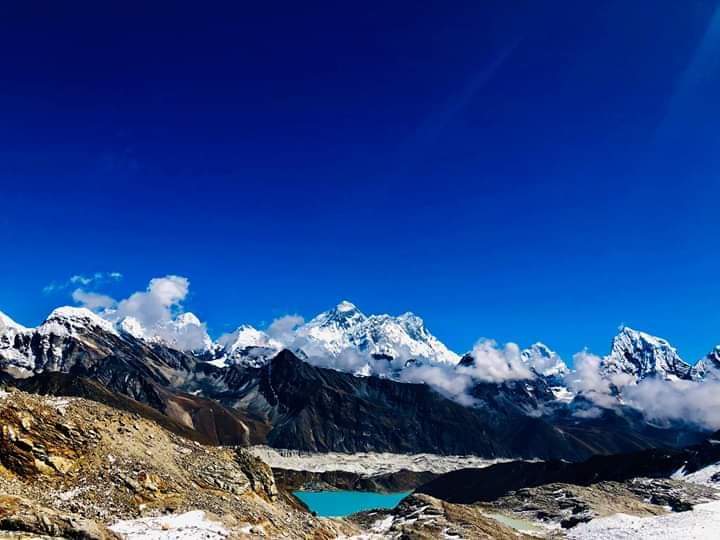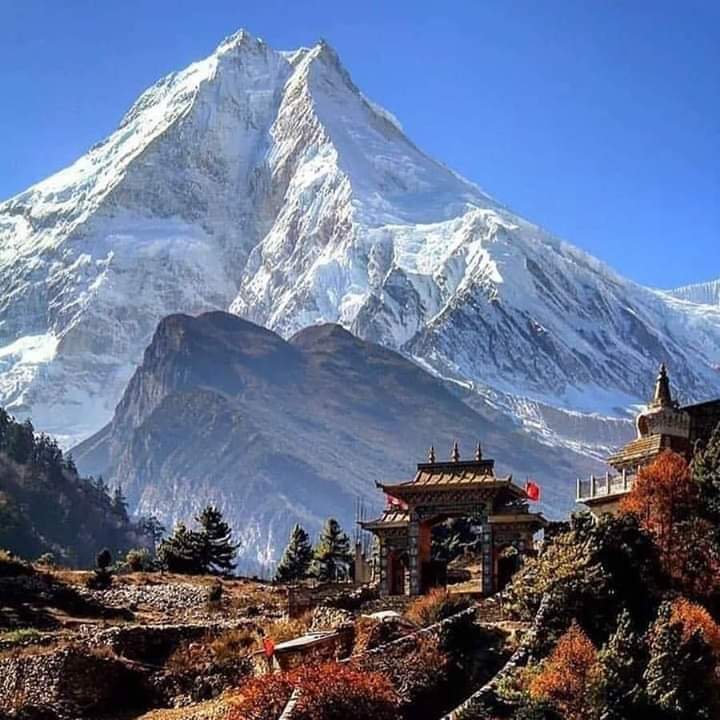
Annapurna Region
Annapurna Region has alluring mountains and is one of the few regions of the world that makes your dream come true. Also, it has evergreen forest, glaciated rivers, and the world’s deepest gorge that will set your mood. Each of these impresses you magically, and each part of the Annapurna has an undeniably beautiful rich biodiversity. Call it the Annapurna Region or the Annapurna Sanctuary; both mean the same thing. This region has some of the rarest vegetations, and its natural sceneries are epic. Side by side, it is home to rare animals. The common vegetation that it has is alpine vegetation. With the Annapurna massifs, this region becomes one of the best trekking destinations in the world. The massifs consist of Annapurna I, Annapurna II, Annapurna III, Annapurna IV, Annapurna South, Machapuchare, Nilgiri, Dhaulagiri, Himchuli, Lamjung Himal and others, and they hug both your eyes and mind as you look at them. Annapurna Region boasts of these mountains and is also home to ethnic groups like Gurung, Magar, and Thakali people, where historians and sociologists can study about their origin, cultures and traditions from scratch.
Annapurna Region is all about trekking to the Annapurna Base Camp, Poon Hill Ghorepani, and the Annapurna Circuit. It is also about swallowing beautiful scenes of the panoramic view of mountains.
You can embark on your lifetime trip to the Annapurna Region either by driving or flying to Pokhara. After all, Annapurna Base camp Trek is the second-best trek of the world, and its trekking trail is scenic.
Good for:
Views
High Passes
Comfortable Lodges
Apple Pie
North of Pokhara, the Annapurna Massif includes 14 peaks that exceed 7000m, including Annapurna I (8091m), the tenth highest summit. Even better, this vast mass of rock and ice can be completely circumnavigated on the Annapurna Circuit trek, with impressive infrastructure all along the route (not for nothing is this known as the Apple Pie trail). Every year, road building nibbles away at the ends of the trek, but the current route from Besi Sahar to Jomsom ranks as one of the world’s most epic trekking trails.
The circuit is just one path through the Annapurnas. Almost as popular is the ten-day tramp to the Annapurna Sanctuary, base camp for attempts on Annapurna South, and dozens of smaller trails link the mountain villages north of Pokhara for less ambitious trekkers. At the other end of the spectrum, remote Mustang and Nar-Phu offer expedition-style detours off the Annapurna Circuit for trekkers with special permits, visiting parched high-altitude deserts that are havens for Tibetan Buddhist culture,
Classic Treks:
Annapurna-14-Days-Trek – A Journey To The Heart Of The Annapurna, Through Valleys Iced By Mighty Glaciers.
Annapurna-Circuit-Biking – The Definitive Annapurna Trek, Circling The Massif And Crossing The Breathless Thorung La (5416m).
Mardi-Himal-Trek – A Journey To The Heart Of The Annapurna, Through Valleys Iced By Mighty Glaciers.
Explore-Himalaya – A Journey To The Heart Of The Annapurna, Through Valleys Iced By Mighty Glaciers.
Annapurna-Circuit-Trek – The Definitive Annapurna Trek, Circling The Massif And Crossing The Breathless Thorung La (5416m).
Langtang, Helambu.
Langtang is the best when it comes to the nearest trekking destination and endless choices from Kathmandu. It is also the best for beginners. And its starting point (trek point) can be reached by bus or van. It is convenient to get to Langtang because there is no fear of mountain flying, and no worrying about long, hilly drive.
The famous treks of the Langtang Region are Gosaikunda Trek, Langtang Valley Trek, Bhairav Kunda Trek, and so on. Each of these treks is gorgeous.
Travellers could spend from a week to more than 13 days to see beautiful Langtang Region. This region is least visited by the trekkers because they do not know much about it; therefore, it is the best choice for the people, who want to walk on a lonely trekking trail. Walking on this trail is fulfilling your dream. We may be dimly aware of the Langtang Region, but it has its own story, that is, it has intact culture and traditions. When we see its green lush valley, we feel that the Langtang Region has something to offer for every traveller.
The region is also popular for Yak Cheese Factory, and we will also find a good cheese there at any time of the year.
Each lake of the Langtang Region bears religious significance (Hindu and Buddhist). We will also come across monasteries, Buddhist prayer flags, chortens, and mani walls.
Another special highlight of the Langtang Region is the Langtang National Park, which is home to rare species of plants and animals. It is also home to Red Panda and snow – leopard.
Langtang Valley Trek – Restored after the 2015 earthquake, the trail to Kyanjin Gompa is back on the map as a classic short trek, within easy reach of Kathmandu.
Tamang Heritage Trail – Restored after the 2015 earthquake, the trail to Kyanjin Gompa is back on the map as a classic short trek, within easy reach of Kathmandu.
Manaslu
The sceneries of the Manaslu Region are exceptional and give a combo experience to both trekkers and adventure seekers. It also includes the Manaslu Mountain that lies in the background and that gets a lot of attention. This 8000 m mountain is the fifth highest mountain in the world. This mountain also makes the region ideal for trekking.
Other special highlights include the Manaslu Conservation Area and its attractions, such as rare floras and faunas. As we trek in this area, we can enjoy its evergreen staggering forest. This area can be said as the centre of peace. Like other trekking regions, the people of the Manaslu Region are also engaged in agricultural activities, and they have their own dialect, culture, custom, dresses, dance and songs, and each of these is a great new thing to see. There will be vibrancy in our eyes when we see colourful prayer flags, mani walls, chortens, and stupas. All these create a little Tibet in Nepal. As we trek further, the guide resurfaces about the hidden culture of the region. We pass the monasteries, and it emerges on our minds that everything about the Manaslu Region is sacred. It also has caves.
As we walk in the calmness of the floras; there is an abundance of vegetations, and their colourfulness gets lively as we walk along with them. All, we have to do is to enjoy this dynamic feature of the Manaslu Region amidst nature. We will also find happiness, and this can be looked upon as a magnetic side. Moreover, we may spot Red Panda and Snow – Leopard.
Manaslu Circuit Trek – A high-altitude epic, through valleys well off the beaten path, in the shadow of mountain giants such as Himlung Himal (7126m) and Manaslu (8163m).
Eastern Nepal
Good For:
Peace and quiet
Empty trails
Close up views of Kangchenjunga
Compared to the established trekking routes around Everest, Annapurna and Langtang, Nepal’s rugged east is uncharted territory. Crude teahouses dot the lower slopes in summer, but the high altitude valleys are only accessible on camping expeditions, with special permits and guides. In exchange for foregoing Wi-Fi and apple pie, you get unparalleled vistas of Kangchenjunga (8586m), the third-highest peak on earth.
If Kanchenjunga feels too ambitious, consider the world’s fifth-highest peak, Makalu (8463m). Just a trickle of independent trekkers attempts the trail, which links widely-spaced teahouses and camping grounds en route to the mountaineers’ base camp at 4870m. An added plus of trekking anywhere in eastern Nepal is tongba, traditional millet beer served warm in wooden tankards to stave off the mountain chill.
Western Nepal
Good For:
Mountain lakes
Remove monasteries
Trekking off the map
Trekkers who venture to the west of Nepal enter a world of pristine wild scenery, icicle-clear mountain lakes and ancient Buddhist kingdoms edging onto the roof of the world. There’s little support for trekkers here; most routes are only accessible by mountain flights, and you’ll need a trekking company to arrange restricted-area permits, guides, packhorses, camping equipment and food. The reward for all this planning, organising and expense is the chance to trek far beyond familiar Nepal, meeting remote communities who have been touched only lightly by the modern world.
Most visitors drop in via the airstrips at Dunai and Jumla, but a few hardy souls trek into Dolpo overland from Beni, following a route made famous by Peter Matthiessen’s The Snow Leopard. The placid lakes of Phoksumdo and Rara are impossible pools of blue-ringed by unknown mountains, while Shey gompa and Humla offer glimpses of ancient Buddhist civilisations that cling on only in the remotest valleys in the Himalaya. Best of all, you can trek for days without seeing a glimpse of Gore-Tex, beyond your own small trekking group.



